Brene Brown always asks her podcast guests this question: “What is the best or worst piece of leadership advice you have received?”
I wondered what is the worst trimming advice I have ever been given? What are the worst trimming rules that I see commonly followed? For the sake of being concise, I will just pick one.
Worst Most Common Trimming Rule
My least favorite trimming rule that we have all heard is that we are supposed to trim the heels to the widest point of the frog.
First of all, just because you read something in a book or someone told you to do something doesn’t make it true. Or at least, true for you and your situation.
Second, I rarely trim back to the widest point of the frog.
Defining the Terms
Let’s define some terms.
If you are looking at the sole, “trim back” means to lower the heel height that is sticking up above the sole – usually by pulling or pushing your rasp across the heels to remove wall material.
“To the widest point of the frog” means to lower the heel height until the heels are flush with the widest point of the frog.
In theory, people claim this “backs the heels up” or brings the weight bearing surface of the heels back underneath the horse – since so many horses have underrun heels – that have grown at the “wrong” angle too far underneath the hoof and are no longer supporting the foot.
I have also heard people say that the heel tubules in the wall have grown forward and you need to rasp the heels in the opposite direction to disrupt that pattern.
However, the back ⅓ of the hoof is all soft tissue internally. When we are trimming the heels, we are indeed changing where the horse is weight bearing on those two little spots at the lateral and medial heel wall that are ground bearing.
But we are largely not in control of what the soft tissue (lateral cartilages, digital cushion, heel bulbs, etc) is doing, at least in the moment.
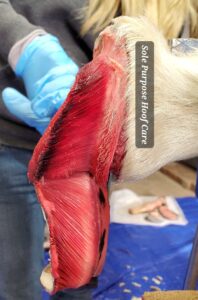
This is a dissection photo from a recent clinic. Look at the collapsed tissue/hairline at the heel, and how the laminae themselves are squished/run forward instead of standing tall and strong.
Considering Both Solar + Lateral Views
If we look at the sole view, we will see heels running too far forward. If we look at the lateral view, we will see to what degree the heels are underrun and can compare to the angle of the dorsal wall.
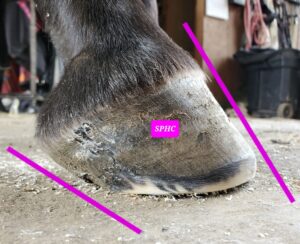
See how the angle of the dorsal wall looks good, but the angle of the heel is totally different and is “running under” the hoof rather than standing up more? This horse was already in the middle of hoof rehab with me, the underrun heel started out a lot worse than this.
If we trim while only considering the sole view, it may make sense (depending on how much heel height we have to play with) to trim the heels down in height/back towards the widest point of the frog.
This could make the heels less run forward, it could bring the weight bearing surface further back.
BUT.
You cannot trim the heels without losing heel height.
What if you have a horse with “low” heels?
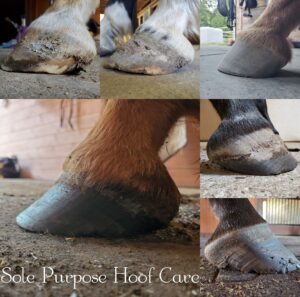
Above you will see various feet that have “low” or “underrun” heels.
Some of these feet have an opposite “high” hoof, but not all.
Low heels are already too close to the ground.
The soft tissue is in various stages of collapse.
The hoof is three dimensional, after all, so you have to consider the entire hoof.
If you also consider the lateral view while deciding how to trim, you will see that if you remove any heel height on these “low” feet, you will be dropping the soft tissue/hairline farther towards the ground. Which will compound the issue even further.
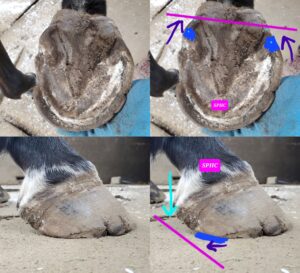
I made a poorly drawn diagram to explain!
On the top row, look for the blue drawn on the heels. That is the surface area that you would trim with your rasp. The pink line is the widest point of the frog. The purple arrows show how you’d be bringing the heel back to that pink line.
On the bottom row, you will see how the soft tissue in the back of the hoof is collapsing towards the ground. The hairline drops down after the quarter. The blue shows the heel trimming that you would do if you brought the heels back to the widest part of the frog. You may move the weight bearing surface of the heel back, but you will also be bringing the hairline even closer to the ground.
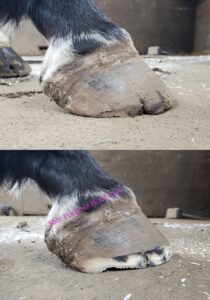
Instead, I left the heels completely alone, and only trimmed the toes back and the flares in. The hairline and heels look better post trim despite me not touching them at all, other than my bevel coming all the way around the outside of the heel.
Removing heel height in these cases may make a slight cosmetic difference when looking at the solar view, but would potentially be a mistake when considering the lateral view and the big picture of rehabbing the hoof.
We like heel height!
ALSO.
We want heel height! Horses should have strong, robust heels. The problem with horses with “low” feet is either that they have no heels at all, or they have heels that are growing in the wrong direction.
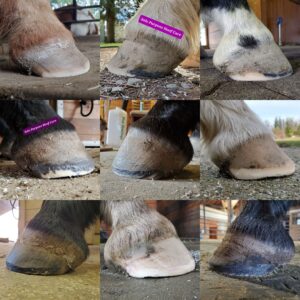
Above are photos of feet in various stages of rehab from having underrun heels. Notice how the hairline angle is softer, there is stronger and more plump soft tissue in the back of the hoof, and the heels are no longer collapsing towards the ground.
![]()
This hoof has an underrun heel BUT we have plenty of heel height here, it’s just going the wrong direction. Instead of supporting the hoof, it is running under the hoof towards the middle of the quarter.
My Approach
My approach is to work on the front ⅔ of the hoof first. I bring the toe back and address any flares. I do this as often as I need do – usually every 4-6 weeks, but sometimes I do shorter trim cycles or recruit my clients to do touch ups in between depending on the situation. As the front ⅔ of the hoof gets into better balance, the heels start to stand up on their own.
It’s a magic formula that I have documented countless times. I would never have known this was happening except I was diligent about taking lots of hoof photos and tracking progress.
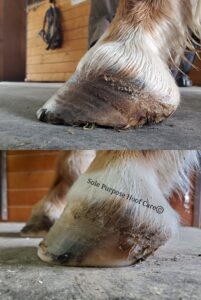
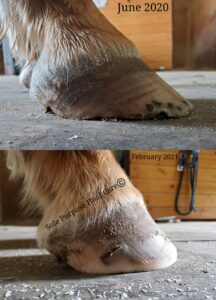
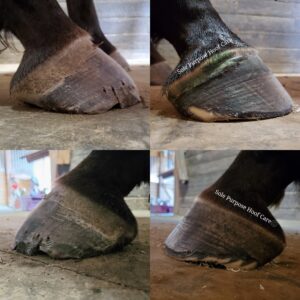
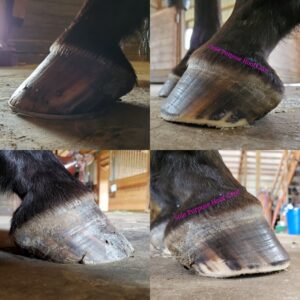
I Do Trim Heels, Sometimes
I am not saying I never trim heels. I trim heels on horses who have heels that are too high or unbalanced. I trim heels on horses who have more upright or clubby type feet. I just trimmed heels on horses today!
But when I am working on a horse with low heels or no heel height at all, especially no heel height above the sole, why would I trim anything away?
I have some horses on my schedule who have never had their heels trimmed by my rasp. This is especially true on some hind feet.
This magic formula does not always work. If I have had a horse on my schedule for 6 months, on my recommended trim cycle, and we aren’t seeing enough caudal hoof progress – then I start looking around because something else is going on.
What Are We Missing?
Reasons why you’re not seeing progress with the heels:
Inflammation/event lines/laminitis (either subclinical or acute).
Lack of good nutrition – many horses are lacking enough copper and zinc in their diet, just to name one problem area.
Sensitivity to vaccines/steroids/injections – I have lost progress on “low” feet after some vet visits.
Hard abrasive footing is causing heels to excessively wear during turnout or exercise.
Horse is landing toe first and avoiding using the back of their hoof. This could be due to long toes, thin soles, body stiffness/soreness, arthritis joints, etc.
Someone is over trimming the heels – the horse can only put back so much material in between trim cycles.
This is just some food for thought.
Conclusion + Encouragement
I think the industry standard of trimming heels back to the widest point of the frog does not help underrun heels, low heels, or weak soft tissue.
Just because we have a tool in our hand doesn’t mean we have to use it on every part of the hoof at every trim. This is my plea for more thoughtful trimming of the heels.
Trimming the heels back to the widest point of the frog is such common practice that I am sure many farriers will disagree with me on this. But if you are a professional or trimming your own, I would encourage you to experiment with trimming the heels differently or not at all! Take pictures and see what happens. I would love to hear how it goes!

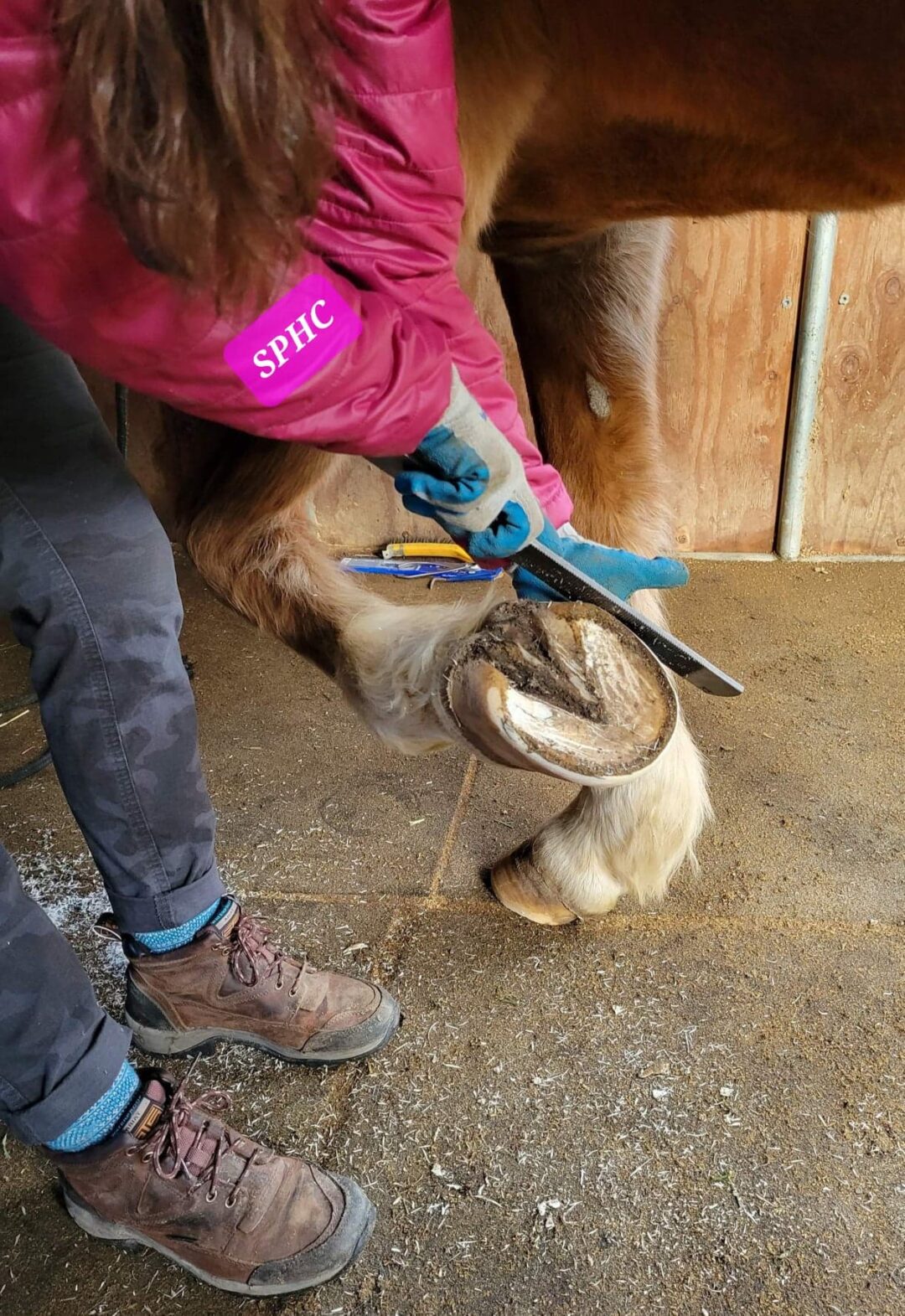
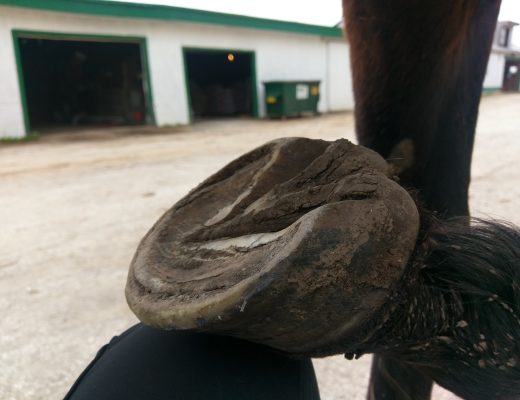
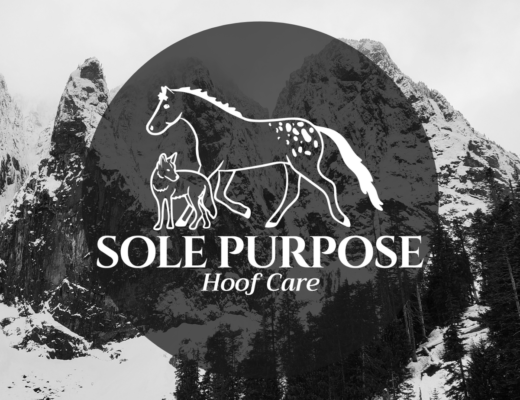
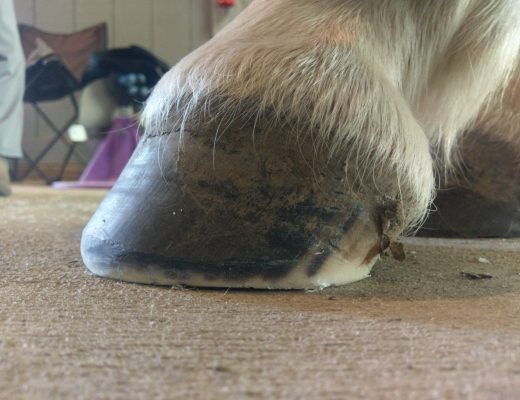
10 Comments
Sue Schnur
March 10, 2022 at 6:37 amWonderfully written and explained.
Corrie Mannion
April 1, 2022 at 5:38 pmThank you, Sue!
Rochelle
March 14, 2022 at 8:12 amThanks for the article. I wholeheartedly agree.
What about bars? Do you address those?
Corrie Mannion
April 1, 2022 at 5:38 pmBars seem to be the source of a lot of conflict in the hoof care world. I treat them differently on each horse at each trim. As an extension of the hoof wall, I try to encourage them to be supportive of the rest of the hoof, remove any flare or distortion, and trim away any diseased/weal material.
Karen Cox
March 16, 2022 at 7:45 amExcellent article. I am a hoof boot rep and have shared it with my hoof boot users group and they are finding it very helpful in understanding underrun heels. This is the #1 issue I encounter when fitting hoof boots. Thank you Corrie!
Corrie Mannion
April 1, 2022 at 5:38 pmThank you Karen, so glad this was helpful!
Kathy Keba
April 7, 2022 at 8:42 amThank you for reinforcing what I knew in my heart, that I needed to dump the farrier who insisted that taking off heel would take them back where they belong. I’m back to trimming them myself, only toe, quarters and laid over bars. I will look to see if you have an article on contracted heels. He’s sound, but you would roll your eyes if you saw his feet. He’s Pasofino, and his feet are similar to my first mare, who was paso also. Sure wish you were in NY, lol.
Donnah Winslow
September 15, 2023 at 7:32 amWow, thank you so much for this eye-opening article.
Éowyn
November 18, 2024 at 5:38 pmWowza! I’m with Donnah – such an eye-opening piece! You have a gift for explaining things!
Claire
December 8, 2024 at 11:47 amThank you! I have chewed my nails over what I felt was happening. And the trim advice I kept seeing! Makes perfect sense.